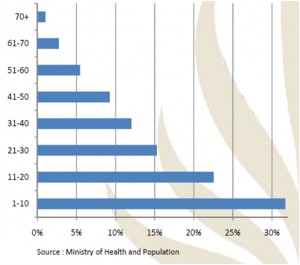By: Lamia Nabil
French industrial company Lafarge announced a new project to develop affordable housing for low-income families. The announced project is part of the Egyptian government’s urbanisation plan to shift population growth into new locations, most being east of the Nile river bank. Some regions have a targeted growth rate of 900% for the next 20 years.
Director of the Affordable Housing Sector for Lafarge Philip Moran said many governments cannot afford to heavily subsidise the capital-intensive housing sector with the hope of solving the housing shortage. While some progress has been achieved at the policy level, so far most private initiatives sponsored by developing country governments have benefited middle-income rather than low-income families.
Moran added that serving the needs of millions of families will require combining the talents and resources of both ordinary citizens and the private sectors. He argued that these concurrent trends provide the right environment for an unprecedented level of business-social congruence to address the central challenge of scale by leveraging the core competencies of both sectors.
The “low-cost housing” that is produced is often inadequate to meet the real needs of the poor, and developing an appropriate offer must begin with an understanding of the end-value, Moran said. He provided examples of Lafarge’s success in areas such as micro lending in Indonesia, slum rehabilitation in India, and collective housing in France.
Lafarge organised a team of experts to study Egypt’s affordable market and its needs for building comprehensive economical and technical solutions in terms of financing systems, community development, housing building, infrastructures, roads and bridges, and schools and hospitals.
Egypt is the second largest domestic market for housing in Africa and Middle East, with an annual growth rate of 1.9%. About 70% of the population are under the age of 30, and Cairo has three of the 30 largest ‘mega-slums’ in the world.
Egypt’s population is living on 5.5% of the total area of the country; 55% in rural areas and 45% in urban. Annual urbanisation is 3.1%, with about one million people migrating from rural to urban areas. Some 78% of the housing demand is attributed to new marriages.
Real estate remains one of the highest-yielding and most consistent investments in Egypt, even surpassing returns earned through bank deposits and stock market investments.

Egypt faces a shortage of affordable housing supply for the poor despite the presence of five million vacant units, according to the 2006 census, in addition to about 440,000 to 600,000 new housing units needed annually between now and 2020, of which 300,000 are low-income households.
Egypt’s housing and development budget is EGP 3.9bn, an approximate 38% increase from the 2011/2012 fiscal year.
Public social housing programmes will not be able to fill the total gap in supply without real participation from the private sector.
The World Bank (WB) recently awarded Egypt a €225m loan to support social housing programmes and fill this gap. The WB and the Egyptian government reached an agreement to allocate 40% of the sum to rehabilitated slum areas. So far, €150m has been distributed.
The private sector dominates the total real estate supply by 80%. The majority of this, approximately 45%, is directed to serve those with low-income levels, whereas 40% and 15% of total supply are directed to middle and high-income segments, respectively.
The number of mortgage finance lenders has increased to 12 companies in addition to the Egyptian Mortgage Refinance Company (EMRC) and 30 banks.
According to the Housing and Building National Research Centre, 34.5% of income is spent on housing. With property prices at an average of seven times the annual income, it would take an average of 19 years to pay for a house in Egypt.

Mortgage finance in Egypt represents less than 1% of GDP, with a penetration rate of 2% indicating there is considerable scope for growth.




